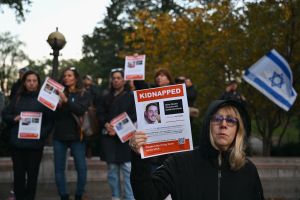Churches are 'uniquely positioned' to make a difference in human trafficking fight: expert

Ashleigh S. Chapman, a human rights lawyer and the founder of Engage Together, an organization that helps individuals and churches combat human trafficking, says God has commanded believers to get engaged in the global scourge.
Chapman’s Engage Together offers churches, educators and businesses the tools needed to identify and respond to human trafficking in their communities.

“God’s heart for justice, protecting the vulnerable, and freeing the enslaved is made clear time and time again throughout Scripture,” Chapman told The Christian Post.
As one of the world’s fastest-growing criminal enterprises, human trafficking is a $150 billion-a-year industry. It's estimated that 40 million people worldwide are trapped in some form of modern-day slavery.
Through her 20 years of work, education, research and advocacy, Chapman, an expert in the prevention of human trafficking, offers educational resources through Engage Together's online learning platform Justice U.
Justice U delivers knowledge from an array of experts in the anti-trafficking movement.
The following is an edited transcript of The Christian Post’s interview with Chapman, where she details how believers can practically become the hands and feet of Jesus by responding to human trafficking. She details the various forms it takes and how it affects its victims.
Christian Post: Why should Christians get involved in the battle against trafficking?
Chapman: Because we are commanded by God to do so. God’s heart for justice, protecting the vulnerable and freeing the enslaved is made clear time and time again throughout Scripture. Psalm 82:3-4 and Luke 4:18 are two excellent examples.
Plus, it is very likely that your church is already engaged in efforts that are connected to combating human trafficking. Youth groups, children’s ministries, prayer nights, homeless outreaches, single parent support networks, foster care and adoption initiatives — and many other efforts — can be enhanced to serve, identify and restore those who are at risk or might have already suffered harm.
In addition, as a church, you often know the needs of your community better than anyone. And as a church, you can identify and fill gaps in service that other entities cannot. By leveraging the many and varied skills, talents and gifts that individual members within your church possess, you are positioned to create exponential impact on behalf of the oppressed and the vulnerable.
CP: What led you to launch Engage Together?
Chapman: Years ago, we started mapping anti-trafficking efforts all around the world — trying to discover who was doing what, where, with whom, and how; what was working, what wasn’t, and what resources existed.
In that process, we built relationships with thousands of organizations and justice advocates working in the field. What we discovered was that people just didn’t know that each other existed (even in the same community), or what resources were already available, or what solutions were already working. And we were constantly bridging gaps in knowledge and relationships to accelerate learning curves and impact.
What we also discovered was that people who had recently become aware of human trafficking didn’t know where to start. They were often overwhelmed by the stories and statistics and sometimes chose not to engage at all because they didn’t know how or where they fit in the solution. And that is what birthed Engage Together.
Our desire is to walk alongside those already working in the field to support them and connect them to each other, and to come alongside all those who had just learned about human trafficking to help them in their journey from awareness to action. [We want] strategic action, not reaction.
We launched Engage Together, and all the many resources and tools it now provides, to equip both organizations and individuals with the knowledge and tools they needed to understand how each of their unique gifts, passions, and skills could come together to help end and prevent human trafficking in their local community.
CP: Why is it that few people understand trafficking?
Chapman: People often glean their initial understanding of human trafficking based on what they have seen in the movies or read on the internet or social media. While those mediums can help raise awareness that human trafficking does exist, it can also paint a picture that does not quite match reality.
Human trafficking is complex. And how human trafficking happens can vary widely in a given community or situation. Further, trafficking is often the result of compounding vulnerabilities in an individual’s life.
In the United States, there are over 25 forms of human trafficking happening across our nation right now — including both labor and sex trafficking of adults and children, foreign nationals and citizens.
Human trafficking cases have now been identified in all 50 states. No community is immune. This makes the topic scary, and scary things tend to make us turn away from learning more. But I’m convinced that is because we think there is no way we can be a meaningful part of the solution.
Everything we do through Engage Together is to help people understand the truth about human trafficking, and part of that truth is that every person can make a difference. This is why we are so passionate about creating the resources and tools people need to get equipped and engaged.
CP: How is law enforcement helping to combat trafficking? And what do you think of the media's coverage of human trafficking?
Chapman: Yes, though more still needs to be done.
Federal, state, and local authorities are being trained to identify and respond to human trafficking. If you watched the news this past year, you saw many operations go down across the nation to rescue victims and arrest perpetrators from coast to coast (see here, here and here). And we are so incredibly grateful to all our law enforcement who are engaged in this issue.
However, the reality is, not every officer, judge, prosecutor, social worker, and others in our justice system have received training on human trafficking yet. Laws and policies shift and change. Turnover occurs in leadership at every level. And many communities do not yet quite understand the nexus between human trafficking and the vulnerabilities that are driving it (such as poverty, homelessness, domestic violence, foster care, refugee care, opioid crises, and more).
Addressing the need to equip everyone in a position to recognize and respond to human trafficking (from authorities to the concerned citizen) is why we created both Engage Together and Justice U.
Regarding media, it is a powerful tool. And while media outlets can help raise awareness of the reality of human trafficking, knowing how to report on this topic in ways that use appropriate terminology and imagery, and in ways that do not re-exploit survivors, is an area in which media could improve. In addition to covering breaking stories, media could be a very helpful ally in exposing tactics of traffickers and highlighting resources and programs that exist in local communities.
CP: Who are traffickers? Who are the victims?
Chapman: Traffickers are those who exploit others for profit. Using force, fraud or coercion (or through commercial exploitation of a minor by any means), traffickers control both the victim and the profits generated from the commoditization of that individual through labor or sex trafficking.
Buyers are those who solicit or purchase an individual for labor or sex. Buyers purchase and exploit individuals online and onsite in a variety of places — in homes, hotels, businesses, and more.
Traffickers — and buyers — can be anyone — from a stranger to a close family member.
While there is no one face of a human trafficking victim, certain populations are more vulnerable, including runaway and homeless youth, children and youth in foster care, individuals fleeing violence or natural disasters, and those who have suffered other types of abuse or exploitation in their lifetimes.
It is so important that we are aware of the nexus between vulnerabilities and human trafficking — because right now, there are so very many people in need [due to COVID-19].
If every church in every community were to take it upon themselves to become aware of those in need in their communities and work together to meet those needs before traffickers are able to exploit them, then we would see a massive shift in preventing human trafficking from ever happening in the first place.
CP: What can churches practically do to support these efforts?
Chapman: We break it down like this: What can you do to enhance what you are already doing? What can you do to come alongside those already engaged? And what can you do to fill a gap in your community?
Churches are already serving in every community and often know the needs of their community better than anyone. They are regularly interacting with people who might be vulnerable to human trafficking. They also are in a position to equip their leadership and mobilize church members to respond to the needs of their community. Each individual member of a congregation has an important role to play in preventing and ending human trafficking, as does the church as a whole.
And the truth is, there are not 10 things to do to end human trafficking in your city. There are a thousand things that need to be done. Instead of being overwhelmed by that, see it as an opportunity. And know that there is absolutely something (or many things) your church and members can do to make a substantial impact.
For a comprehensive list of action items and possibilities, we encourage you to download our Engage Together Church Toolkit or go through our Engage Together Church Teaching Series, or listen in to our latest conversation with a local church championand grab the corresponding Quick Start Guide!
CP: What else would you like to add?
Chapman: Do not despise small beginnings! While your church might not be ready to take on a new ministry or partnership, you can absolutely enhance what you are already doing by training staff, including youth workers, outreach, and local and global missionaries, on indicators and how to respond and report.
You can come alongside those who are already serving those vulnerable in your community to exploitation and trafficking and be part of prevention by simply meeting needs, especially housing and food insecurities.
Ask your local law enforcement, social service agencies, nonprofits, and direct service providers what they need in your local community. The possibilities are endless. Just know that your church is perfectly and uniquely positioned to engage in ways that will make a difference. It does not take a huge budget or new ministry to make an impact; starting with what you have and where you already are working is the best place to begin. And always feel free to knock on our door for help!





























